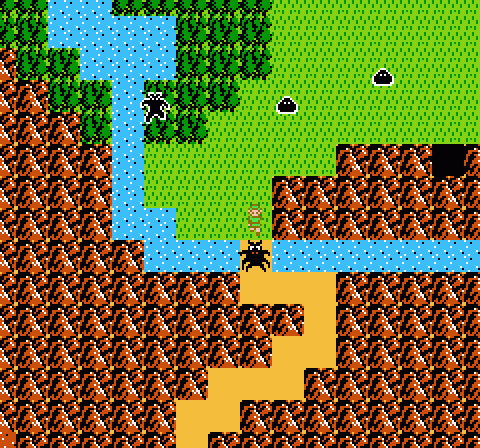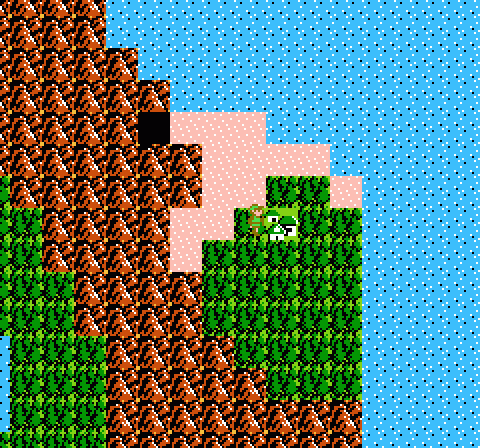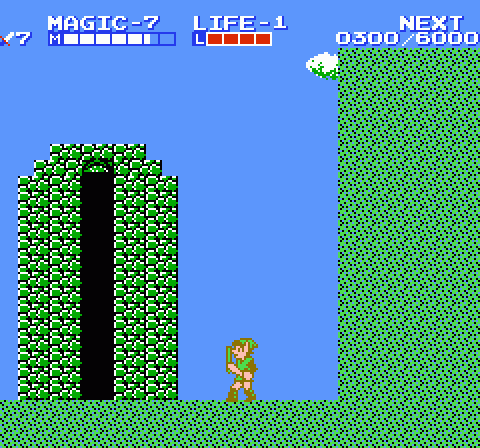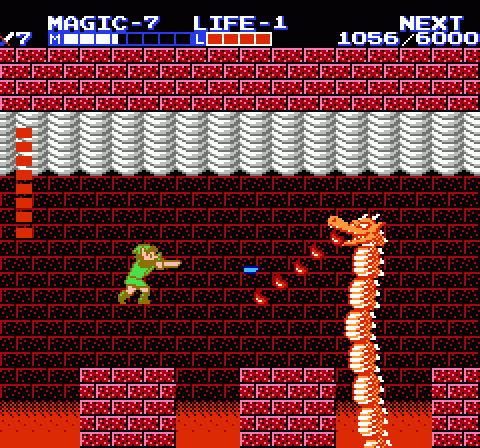While making the trip from the Maze Palace to the Ocean Palace proved to be a snap — basically as simple as walking directly south from one to the other — Zelda II has one final nasty surprise in store for players. The final standard dungeon, the Hidden Palace, is, well, hidden.

This should feel familiar to those who completed the original Legend of Zelda. As in that game, many of the hidden secrets here can be accessed immediately if you know the trick, and the Hidden Palace is perhaps the most extreme example of this phenomenon. Once you know the secret to revealing its location, you can also head there immediately from the previous Palace. The initial challenge, of course, lies in unraveling those secrets from villagers who are curiously knowledgeable about ancient mystical secrets.
You use the funny-shaped key from the Ocean Palace, the Flute, exactly twice in Adventure of Link. First, you use it to vanquish the spider-like River Demon blocking the path to the southern half of the east continent….

Then you use it once again while standing in the center tile of the diamond formed by the palace and the three boulders north of it. But, of course, there’s no way to intuit this without some insanely canny game logic decryption skills, and let’s be honest: You’re not that smart. None of us are. Video game logic in the 8-bit era — before everything was predictable and codified the way it is now — didn’t make a lot of sense.
We can argue at length about whether creative-but-incoherent or rote-and-decipherable is a better approach to game design, but at the end of the day you probably got stuck at this point in the game until Nintendo Power helped you. If only we’d had the Internet back then for sharing tips…
Once you bypass the River Demon — and no, the Boots from the fourth Palace won’t let you walk on the river here — the path south gives you a taste of the nastiness ahead for the remainder of the quest. The “safe” path on the overworld may be free of random encounters, but going forward your critical path is laden with fixed battles that in many ways are much worse.
The most common combat scenario going forward takes the form of a straight march along low, flat ground with a tall wall rising behind it. Lizard men poke their head above the top of the wall and chuck rocks at you as you walk, and believe it or not they have good aim. Their logic routines aren’t your usual “throw randomly in a fixed pattern” affairs so common to games of this vintage; rather, they lead their aim, throwing rocks ahead of Link when you walk full tilt forward so that if you simply try to motor through these phases you’ll take tons of damage.
It’s pretty irritating in practice, but I respect the added effort that went into the hazards here. The developers must have watched play testers (such as they were in the day) make a mad dash for the exit and thought, “No, screw you guys. You’re gonna suffer.” There’s a real dedication to human misery on display here.
Once you pass through these gauntlets and the most frustrating bridge sequences in the game, you reach the town of Kasuto. Ragged and worn down by the preceding combat sequences and the brutally difficult random fights, you duck into the village looking forward to recharging your life and magic. And then you promptly die as the town is empty but for invisible monsters that smash into you seemingly at random and brutalize your life meter. Game Over. The return of Ganon.

Kasuto, as it turns out, has been abandoned but for an old man who proclaims, “This town is dead.” This lends a little more credence to the notion that Zelda II took some pointers from Dragon Quest (with its desolate village of Hauksness), but it also leads to a fairly maddening snipe hunt. The Kasuto holdout tells you to look in the forest to the east, and eventually you’ll probably cotton to the fact that he means the forest along the continent’s eastern edge, separated from the main map by a cavern. But no village appears, and no matter where you walk you’ll never find it by simply passing over the correct tile.
Instead, you have to use the Hammer to knock down trees — a secondary function of the tool you’ve never needed to use prior to this point. While I admire the developers for giving one of Link’s treasure multiple functions as opposed to their usual routine of forcing you to track down a tool to use once or twice, this portion of the game can be quite infuriating if you don’t know about the Hammer’s clear-cutting feature. And you probably don’t, as it’s alluded to vaguely in the manual and never in the game.
Should you manage to find your way to the relocated village of New Kasuto, hidden beneath the trees and inaccessible until you raze the forest, you’ll find your final magic upgrade — essential for completing the game! — and the lamest magic spell in the game. In fact, it’s so lame they didn’t even bother giving it a name. It’s just called “Spell.” The only real use of Spell is to access a couple of buildings in New Kasuto, one of which gives you the helpful (but not essential) Magic Key.

No, the real coup in finding New Kasuto is that the elderly holdout living in old Kasuto will now give Link the Thunder spell, without which you can’t complete the final boss gauntlet. Also, someone tells you the secret to finding the Hidden Palace, mostly.
After all of this, the Palace itself is fairly mundane. It lacks any significant new challenges; the main feature of note is the fact that it features the game’s only recurring boss, the mounted Ironknuckle (Rebonack), who shows up twice. By this point in Link’s murder career, they should be simple, as once dismounted they actually take less damage to dispatch than standard Blue Ironknuckles (two hits with a level-8 sword versus four).

The Palace treasure this time around isn’t a mere key but rather an essential tool, the Cross. (Nice consistency with the mandatory religious censorship, there, Nintendo.) The Cross does nothing for Link besides rendering the invisible enemies that haunt Kasuto visible. Big deal, you may say, but the entirety of the path to the Great Palace is lousy with the things. I suppose it’s technically possible to reach the final Palace without the Cross, but only if you are very, very lucky. Or very, very unafraid to use a GameShark.
Ultimately, the one tricky part of the Hidden Palace is that to reach the boss, you need to drop down a pit and use the Fairy spell while in midair on the screen below so you can fly into a small passage in the wall. Mandatory use of a high-cost magic can be a real pain in this game, since magic refills are random drops from certain enemies (and once you clear a room of foes they almost never return); chances are good you’ll need to farm drops from the few respawning enemies nearby… or else just kill yourself.

After all of this, the Palace’s boss is almost laughably anticlimactic. He rises up from one of three lava pits, waits for a few seconds, belches fire, and ducks back down again. If you time it right, you can hit him three times per appearance — and if your Magic and Life ratings are high, the Shield spell will trivialize his fire attack.
Perhaps not surprisingly, the bulk of the difficulty in this portion of the game stems from unintuitive secrets and poor user guidance, not from sheer tests of dexterity. That changes now, though. With the sixth crystal placed, Link’s only remaining task is to reach the Great Palace and conquer it, but that’s easily the most daunting challenge in the game — in fact, you could argue that it’s the most difficult task in any Nintendo-developed game, ever.
New Kasuto has another benefit: Its forest is the best area in the game to grind for EXP. The lizardmen aren’t too hard to beat, give lots of points, and are right next to a town that refills magic and life. In a previous playthrough I ground outside Nabooru, which was far more tedious.
I found the 4th palace the best place to grind. Wizzrobes and Ironknuckles near the entrance, and a 50/50 chance that the statue at the beginning will yield a red magic refill.
You just summed up, in this one chapter about Zelda II, my thoughts about the game — likely better than I would have, personally. Thanks. This was perfectly insightful.
I got this game when I was 9, and actually made it all the way through Palace 5 at that age. Then I got stuck, because I could not find New Kasuto. Living in Norway, I had just started learning English in school, so I couldn’t really read much of the text in the game yet. It took years when I finally, at age 12, understood what the old fart in Kasuto tried to tell me. Somehow, I knew from trial and error I could knock down trees with my hammer, so once I knew where to look, it didn’t take long.
Once I found New Kasuto, it didn’t take me many weeks to finish the game, but I remember the pain of exploring and mapping the final palace before I eventually found my way.
Finding that town hidden underneath forest tiles was such bullshit back in the day. Once you know it’s there it’ll never be a problem, but I pity the fool who has to figure it out by himself.
About the magic refills, if you hit those Ironknuckle statues they sometimes (randomly?) drop either a red potion or an Ironknuckle. Same with the animal heads mounted on walls, though they seem less likely to drop anything. Smashing statues seems to be the way to go when you’re in need of new juice.
Zelda II was my first experience with the series. I think I was 12 or 13 when I borrowed the cart from a friend. I remember having a pretty good time with it but I could never figure out why I couldn’t enter the Great Palace. I tried for weeks. I threw myself against the barrier time and time again. I ran; I leapt; I tried using the Fairy spell. I maxed out Link’s stats. Nothing. I must have explored every part of the overworld that I could reach convinced I missed something. Nada. I finally gave up and put the game down in disgust.
It never occurred to me that I needed to play the flute to make the Hidden Palace appear
The great thing about this boss is that it’s actually Volvagia (horribly mistranslated as “Barba” but then I believe corrected in some later release - probably the Wii Virtual Console version). Yet another connection Ocarina of Time shares with this game (appropriate given it started as a remake of Zelda 2 :P)
Also, “Spell” will turn most enemies into Bots. So it’s not *completely* useless. But of course, you sacrifice EXP for potentially not having to deal with a tough monster. And actually, I think it may work on the invisible Moa in Old Kasuto (rendering them into something visible), but I may be wrong, it has been awhile.
Yeah, I know about the Bot transformation, but it’s kind of useless — aside from the EXP thing, it also doesn’t work against the goes you REALLY want it to (Fokkas, for instance).
Hallelujah, I’m not the only one that had trouble finding New Kasuto.
Also, a couple of things… magic jar drops are predictable, and I’m pretty sure there’s a villager who helps out with the sixth palace reveal. *checks wiki*
Yeah, some dude says “Call for help at the Three-Eye Rocks.” I did manage to figure this one out as a kid!
1. Yes, loot drops every sixth enemy, but whether it’s EXP or magic seems random so far as I can tell.
2. Yes, as mentioned in the update.